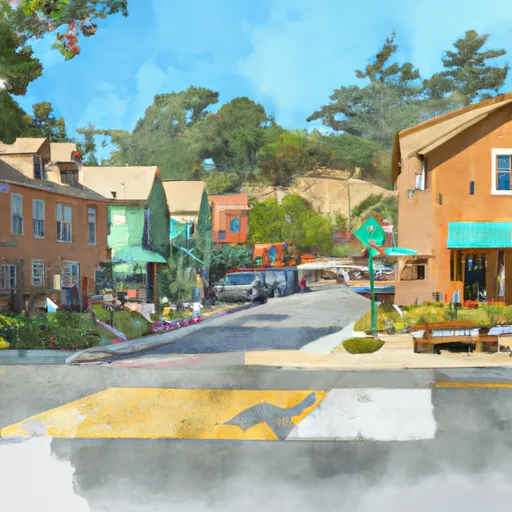-
 Snoflo Premium
Snoflo Premium
Get unlimited access to all our content
With no Ad interruptions! - Start Your Free Trial Login with existing account
Mi-Wuk-Village
Eden Index
Climate
10.0
•
Recreation
6.2
•
Community
3.6
•
Safeguard
7.1/10

Mi-Wuk Village is a small community located in Tuolumne County, California. Situated in the Sierra Nevada Mountains at an elevation of 4,984 feet, the village enjoys a mild Mediterranean climate. Summers are warm and dry, with average temperatures ranging from the mid-70s to low 80s Fahrenheit. Winters are cool and wet, with temperatures averaging in the 40s and annual precipitation averaging around 51 inches, primarily falling as rain from November to April and snow during the colder months.
The village is surrounded by the beauty of nature, with several outdoor recreation opportunities available. The area offers numerous hiking trails, including the popular Sugar Pine Railroad Trail, which winds through the enchanting Stanislaus National Forest and showcases stunning views of the surrounding mountains and forests. Outdoor enthusiasts can also enjoy fishing in nearby rivers and lakes, such as Pinecrest Lake, known for its abundance of trout. Additionally, winter brings opportunities for skiing and snowboarding at Dodge Ridge Ski Resort, just a short drive away. With its pleasant climate and picturesque surroundings, Mi-Wuk Village offers a delightful outdoor experience for visitors and residents alike.
What is the Eden Index?
The Snoflo Eden Index serves as a comprehensive rating system for regions, evaluating their desirability through a holistic assessment of climate health, outdoor recreation opportunities, and natural disaster risk, acknowledging the profound impact of these factors on livability and well-being.
Climate Health Indicator (CHI): 10.0
Mi-Wuk-Village receives approximately
1103mm of rain per year,
with humidity levels near 61%
and air temperatures averaging around
12°C.
Mi-Wuk-Village has a plant hardyness factor of
8, meaning
plants and agriculture in this region tend to thrive here all year round.
By considering the ideal temperature range, reliable water supplies, clean air, and stable seasonal rain or snowpacks, the Climate Health Indicator (CHI) underscores the significance of a healthy climate as the foundation for quality living.
A healthy climate is paramount for ensuring a high quality of life and livability in a region, fostering both physical well-being and environmental harmony. This can be characterized by ideal temperatures, reliable access to water supplies, clean air, and consistent seasonal rain or snowpacks.
Weather Forecast
Streamflow Conditions
San Joaquin
Area Rivers
San Joaquin
Snowpack Depths
San Joaquin
Reservoir Storage Capacity
San Joaquin
Groundwater Levels
Recreational Opportunity Index (ROI): 6.2
The Recreational Opportunity Index (ROI) recognizes the value of outdoor recreational options, such as parks, hiking trails, camping sites, and fishing spots, while acknowledging that climate plays a pivotal role in ensuring the comfort and consistency of these experiences.
Access to outdoor recreational opportunities, encompassing activities such as parks, hiking, camping, and fishing, is crucial for overall well-being, and the climate plays a pivotal role in enabling and enhancing these experiences, ensuring that individuals can engage in nature-based activities comfortably and consistently.
Camping Areas
| Campground | Campsites | Reservations | Toilets | Showers | Elevation |
|---|---|---|---|---|---|
| Lake Alpine | 25 | 7,351 ft | |||
| Big Meadow | 68 | 6,536 ft | |||
| Lodgepole Overflow | 30 | 7,346 ft | |||
| Spicer Meadow | 43 | 6,649 ft | |||
| Pine Marten | 32 | 7,334 ft | |||
| Mokelumne | 13 | 3,240 ft | |||
| Silvertip | 23 | 7,545 ft | |||
| Moore Creek | 8 | 3,297 ft | |||
| Mokelumne River | 13 | 3,234 ft | |||
| Silver Valley | 21 | 7,365 ft |
Nearby Ski Areas
Catastrophe Safeguard Index (CSI):
The Catastrophe Safeguard Index (CSI) recognizes that natural disaster risk, encompassing floods, fires, hurricanes, and tornadoes, can drastically affect safety and the overall appeal of an area.
The level of natural disaster risk in a region significantly affects safety and the overall livability, with climate change amplifying these risks by potentially increasing the frequency and intensity of events like floods, fires, hurricanes, and tornadoes, thereby posing substantial challenges to community resilience and well-being.
Community Resilience Indicator (CRI): 3.6
The Community Resilience Indicator (CRI) recognizes that education, healthcare, and socioeconomics are crucial to the well-being of a region. The CRI acknowledges the profound impact of these elements on residents' overall quality of life. By evaluating educational resources, healthcare accessibility, and economic inclusivity, the index captures the essential aspects that contribute to a thriving community, fostering resident satisfaction, equity, and social cohesion.

